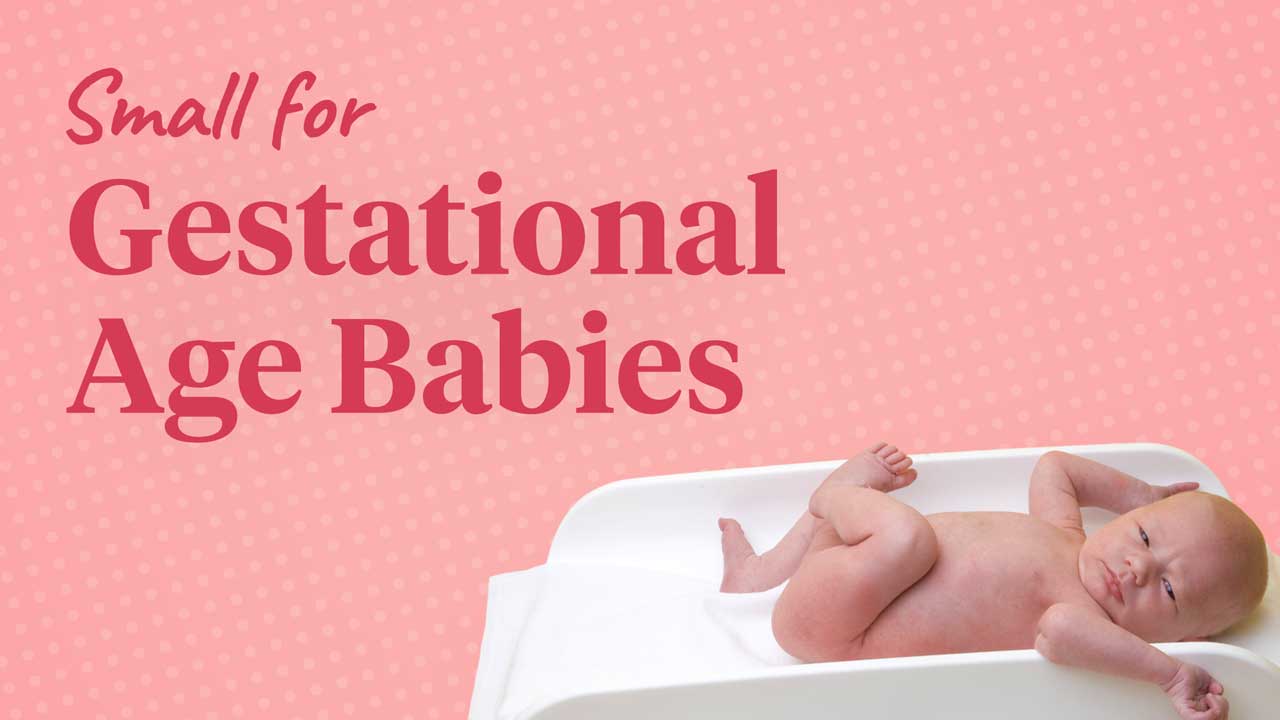When an infant's fetal weight is below the 10th percentile for their gestational age and sex, they are referred to as small for gestational age (SGA) (Pregnancy, Birth and Baby 2023).
These babies fall into one of two broad categories:
- Infants who are constitutionally normal (approximately 40%)
- Infants with fetal growth restriction (FGA) caused by underlying pathology.
(Chew et al. 2024)
For healthy and constitutionally normal infants, low birth weight may simply be the result of factors such as maternal height, weight, ethnicity and parity (RANZCOG 2024).
However, the outlook is more concerning for babies whose reduced birth weight is caused by FGR, which is associated with an increased risk of stillbirth and prematurity. With an overall incidence of about 3% to 9%, the causes of FGR are diverse and may include both fetal and maternal factors (Chew et al. 2024).
Assessing the Rate of Growth
Many SGA babies are first identified upon routine palpation during second and third-trimester antenatal visits when the fundal height appears at least 3 cm lower than expected for the stage of gestation (Chew et al. 2024).
Confirmation is then made via ultrasound scan, which can detect a pattern of restricted growth over subsequent measurements.

Identifying Risk Factors
Of the many studies that have explored the causes of SGA, most identify obesity and smoking during pregnancy as likely causes of restricted growth.
Knight-Agarwal et al. (2020) explored the relative risk reduction of SGA in women who stopped smoking, compared to those who continued smoking throughout their pregnancy.
The results were clear: smoking during pregnancy can inhibit fetal growth. Given the clarity of these results, Knight-Agarwal et al. suggest that antenatal smoking cessation sessions could be a highly effective strategy to reduce preventable infant morbidity and mortality.
Other risk factors for SGA include but are not limited to:
- Maternal age < 16 or > 35
- Substance abuse
- Previous SGA/FGR baby
- Previous stillbirth
- Previous pre-eclampsia
- Chronic hypertension
- Diabetes
- Renal impairment
- Antiphospholipid syndrome
- BMI < 18.5 or > 30
- Uterine malformation.
(Queensland Health 2023; Chew et al. 2024; Pregnancy, Birth and Baby 2023)
Demographic factors can also play a role. In 2017, Kildea et al. specifically looked at the rates of SGA babies amongst Aboriginal women from remote communities in Northern Australia and discovered that the SGA rate was about 16.3%.
Given that people of low socioeconomic status are known to be more susceptible to poor infant birth outcomes, McRae et al. (2018) explored the possibility that enhanced antenatal care could minimise the risk of adverse outcomes for this population of mothers. Not surprisingly, they found that outcomes improved with increased availability and accessibility to the maternity team, but they also flagged the need for further research to determine which aspects of care were specifically of greatest value. For example, it’s still unclear whether psychological or physical care has a greater impact on positive outcomes.
New Australian Birthweight Centiles
Joseph et al. (2020) raise an interesting issue by suggesting that new birthweight charts are needed, based on data for spontaneous singleton births in Australia. If these changes are implemented, it’s likely that some fetuses previously regarded as normal would be identified as small for gestational age. Although it would increase the burden of health care services if more cases of SGA were diagnosed, it may also have the benefit of reducing the incidence of poor clinical outcomes for neonates in the long term.

Identifying the Small for Gestational Age Baby at Birth
Newborn babies who are small for their gestational age have a characteristic appearance that typically includes:
- Relatively large or small head compared to the rest of the body
- Thin appearance with loose, dry skin
- Decreased muscle mass
- Shrunken and wrinkled facial features
- Decreased subcutaneous fat
- Thin umbilical cord
- Widened cranial sutures and larger-than-normal anterior fontanelle.
(Chew et al. 2024; CHOP 2018)
Catch-up Growth
Most SGA babies achieve catch-up growth by two years of age (Queensland Health 2022). This is typically achieved within the first six to nine months of life for approximately 80% of infants born with SGA. Of the remainder, 10 to 15% show slow, attenuated growth, with the remaining 5% to 10% exhibiting a slower catch-up growth pattern between three and five years of age (Cooke et al. 2016).
However, babies with fetal growth restriction who are small for their gestational age are also at increased risk of other complications such as prematurity, neonatal asphyxia, poor thermoregulation, hypoglycaemia, hypocalcaemia, polycythemia and sepsis (Chew et al. 2024). With risks such as these threatening the wellbeing of the baby, it makes sense to invest in the time and resources to ensure patients enter pregnancy in as healthy a state as possible.
Test Your Knowledge
Question 1 of 3
What is the difference between small for gestational age and fetal growth restriction?
Topics
References
- Chew, LC, Osuchukwu, OO, Reed, DJ & Verma, RP 2024, ‘Fetal Growth Restriction’, StatPearls, viewed 26 November 2024, https://www.ncbi.nlm.nih.gov/books/NBK562268/
- The Children's Hospital of Philadelphia 2018, Small for Gestational Age, CHOP, viewed 27 November 2024, https://www.chop.edu/conditions-diseases/small-gestational-age
- Cooke, DW, Divall, SA & Radovick, S 2016, ‘Chapter 24 - Normal and Aberrant Growth in Children’, in S Melmed, KS Ppoonksy, PR Larsen & HM Kronenberg (ed.), Williams Textbook of Endocrinology, Elsevier, viewed 27 November 2024, https://www.sciencedirect.com/topics/agricultural-and-biological-sciences/small-for-gestational-age
- Joseph, F, Hyett, J, Schluter, P et al. 2020, ‘New Australian Birthweight Centiles’, Medical Journal of Australia, vol. 213, no. 2, pp.79-85, viewed 27 November 2024, https://onlinelibrary.wiley.com/doi/full/10.5694/mja2.50676
- Kildea, S, Gao, Y, Rolfe, M et al. 2017, ‘Risk Factors for Preterm, Low Birthweight and Small for Gestational Age Births Among Aboriginal Women From Remote Communities in Northern Australia’, Women and Birth, vol. 30, no. 5, pp.398-405, viewed 27 November 2024, https://www.sciencedirect.com/science/article/abs/pii/S1871519216302256
- Knight-Agarwal, C, Mellor, D, Georgousopoulos, E et al. 2020, ‘Maternal Body Mass Index, Smoking Status and Small for Gestational Age: An Australian Retrospective Cohort Study’, Public Health, vol. 185, pp.381-385, viewed 27 November 2024, https://www.sciencedirect.com/science/article/pii/S0033350620301918
- McRae, D, Janssen, P, Vedam, S et al. 2018, ‘Reduced Prevalence of Small-For-Gestational-Age and Preterm Birth for Women of Low Socioeconomic Position: A Population-Based Cohort Study Comparing Antenatal Midwifery and Physician Models of Care’, BMJ Open, vol. 8, no. 10, viewed 27 November 2024, https://bmjopen.bmj.com/content/8/10/e022220
- Pregnancy, Birth and Baby 2023, Having a Small Baby, Healthdirect Australia, viewed 26 November 2024, https://www.pregnancybirthbaby.org.au/having-a-small-baby
- Queensland Health 2022, Small Baby Born at Term, Queensland Government, viewed 27 November 2024, https://www.health.qld.gov.au/__data/assets/pdf_file/0017/140138/c-sga.pdf
- Queensland Health 2023, Maternity and Neonatal Clinical Guideline: Term Small for Gestational Age Newborn Baby, Queensland Government, viewed 27 November 2024, https://www.health.qld.gov.au/__data/assets/pdf_file/0034/139939/g-sga.pdf
- The Royal Australian and New Zealand College of Obstetricians and Gynaecologists 2024, Fetal Growth Restriction (FGR) / Having a Small Baby, RANZCOG, viewed 26 November 2024, https://ranzcog.edu.au/wp-content/uploads/Fetal-Growth-Restriction.pdf
 New
New 
